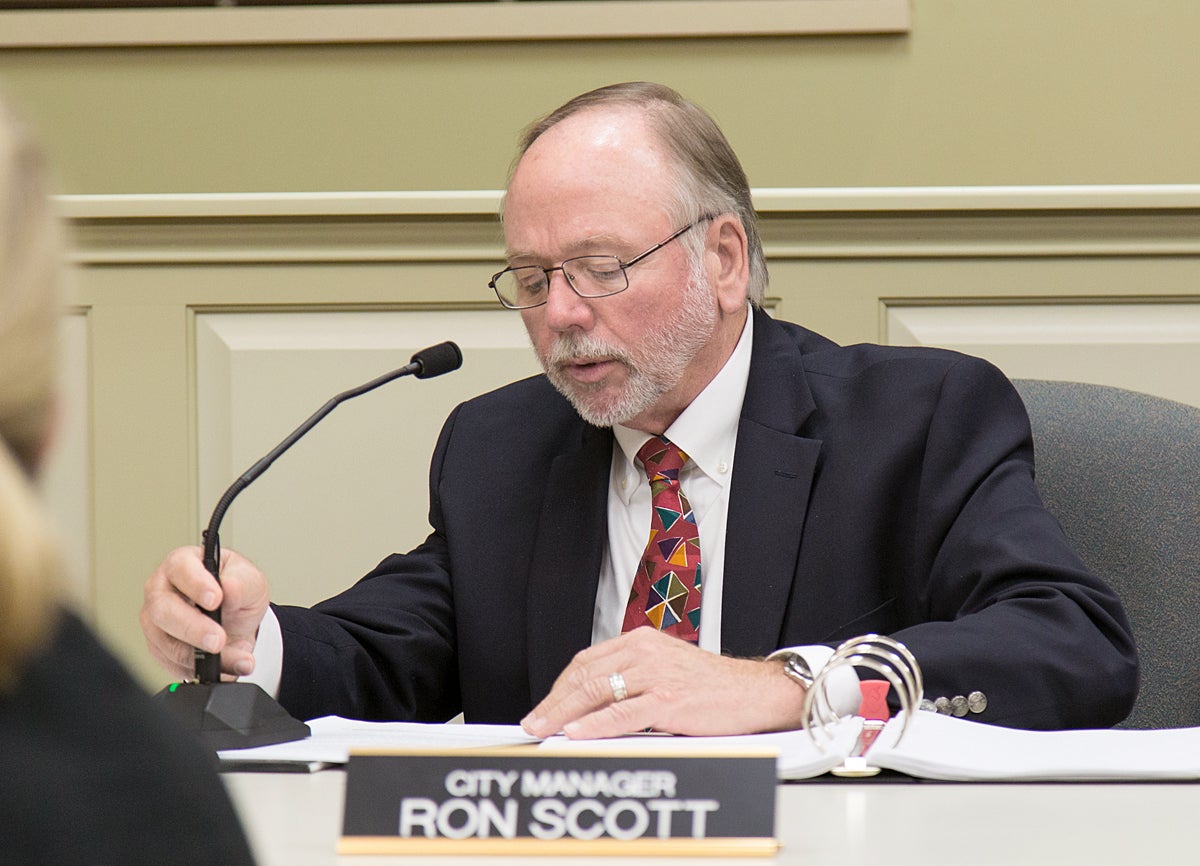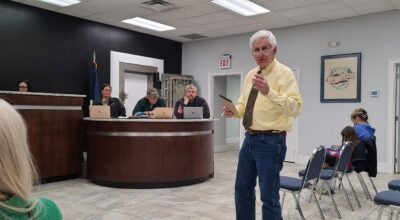Could ‘TIF’ district could help revitalize ‘blighted’ areas?
Published 10:44 am Wednesday, October 25, 2017

- Ben Kleppinger/ben.kleppinger@amnews.com Danville City Manager Ron Scott explains the concept of a TIF district during Monday night's Danville City Commission meeting.
Danville plans to spend up to $20,000 looking into the possibility of creating a “tax increment financing” district in the city.
Such a TIF district could allow Danville to revitalize a “blighted” area without increasing taxes, City Manager Ron Scott told commissioners Monday night.
“It’s simply a boundary that is established either by city or county or jointly that will utilize the increased revenues that might be generated by businesses locating in that district to pay for the developmental cost of new facilities (in the district),” Scott said. “It’s used as a form of revitalization in distressed areas of cities. It is not a tax increase on any business located in such a district; it doesn’t change the manner in which taxes are levied or collected. It simply utilizes … growth in those taxes to help fund a project that will presumably have an overall economic benefit to the area and to the community.”
After hearing from Scott about TIF districts and their use in larger cities around Kentucky such as Lexington, Louisville and Covington, Danville City Commission voted 4-1 in support of signing a contract with attorney James E. Parsons of Keating Meeting & Klekamp to examine if Danville could benefit from creating a TIF district of its own.
The contract states Danville will pay $270 an hour for Parsons’ services, “up to a capped amount for legal services of $20,000, plus out-of-pocket costs for travel and copy costs.”
Scott said he is authorized as city manager to approve costs that do not surpass $20,000, but he still wanted to make the commission aware of the situation and seek its support.
After questioning if Danville should first talk with Boyle County officials about any potential interest it would have in a TIF district, City Commissioner Rick Serres voted against the motion.
Serres said after the meeting he wished he could have had more time to think about the proposal before a vote, and he would have liked to see Boyle County included in the conversation.
“If we move forward and we want their cooperation, it would be nice if they knew what we were doing,” he said. “… I don’t think it’s a bad idea; I just don’t like rushing into things.”
According to the Kentucky League of Cities, tax-increment financing “permits local governments to capture future increases in property and other taxes generated by new development within a specified development area. The captured value of the increase in tax revenues is used to attract private development or to finance public improvements for economic development projects.”
“TIF is primarily used to help a local government jumpstart improvements in declining or underperforming urban areas where development would not otherwise occur,” according to KLC. “The ‘but for’ test is often used to describe TIF-funded projects. ‘But for’ the TIF-funded public improvements, development would not occur.”
According to the state Cabinet for Economic Development, also known as Think Kentucky, TIF districts can remain in effect for “blighted urban redevelopment areas” for up to 30 years, and a local government can authorize up to 100 percent of new property and payroll taxes to go toward a project revitalizing the same area.
A theoretical example: A one-block area is generating $10,000 in property taxes and $10,000 in payroll taxes. The city designates the one-block area as a TIF district, then demolishes dilapidated buildings and constructs a public park. The cost of the demolition and park construction is paid back over time as tax revenues in the district rise. A business locates next to the park and property values increase. Now the district generates $15,000 in property taxes and $20,000 in payroll taxes — a total of $15,000 more in taxes than were previously generated. The additional tax revenue is used to pay off the debt incurred tearing down the buildings and building the park.
According to Think Kentucky, blighted TIF districts must meet certain requirements in order to be legal. One way to qualify is if the district meets two of seven “blight/deterioration” conditions:
• “substantial loss of residential, commercial or industrial activity or use;”
• “40 percent or more of the households are low-income households;”
• “more than 50 percent of residential, commercial or industrial structures are deteriorating or deteriorated;”
• “substantial abandonment of residential, commercial or industrial structures;”
• “substantial presence of environmentally contaminated land;”
• “inadequate public improvements or substantial deterioration in public infrastructure;” or
• “any combination of factors that substantially impairs or arrests the growth and economic development of the city or county …”
According to a 2011 report by the Public Interest Research Group Education Fund, TIF “has been a leading tool” in encouraging economic development in “challenged areas.”
“When used properly and sparingly, TIF can promote enduring growth and stronger communities,” according to the PIRG report. “When used improperly, however, TIF can waste taxpayer resources or channel money to politically favored special interests. To protect the public interest, governments should impose strong safeguards that ensure that TIF projects are implemented through a transparent, accountable process with clear and compelling goals.”
Danville Mayor Mike Perros said he “applauds” Scott for pursuing the possibility of a TIF district in Danville.
“We do have to seek every way possible to invent economic development,” Perros said. “You show me a community anywhere, any community in the nation that has a nice area, nice water fountain, (etc.), I guarantee you they used TIF financing to do that. We probably should have already done this some years ago.”
Commissioner Kevin Caudill motioned to approve hiring Parsons and investigate TIF further. Commissioner Denise Terry seconded the motion.
Serres then questioned if the city should work with the county and if there was “some rush to get this going.”
“There’s not an immediate urgency if you don’t view economic development as an immediate need,” Scott said. “But if you view it as an immediate need, why wait, as we’re simply engaging in professional services to begin a study.”
City Attorney Stephen Dexter said he believes it would be “premature” to involve the county government at this point in the process. If Danville identifies a possible TIF district down the road, it could then talk to the county about possible involvement.
“This is in the preliminary stage, like the Daniel Boone stage of exploration. There’s no settlement to look at to see who wants to be protected by the fort, so to speak,” Dexter said. “We just are trying to see maybe what opportunities are out there, if any.”
Dexter said the city is “routinely asked” by developers about creating a TIF district to help along a business venture.
“Quite frankly, we have not had the time or the expertise to evaluate what that question means to the City of Danville,” Dexter said. “But that would be achieved through the counsel of Mr. Parsons.”
Perros said he thinks the city has to “get comfortable ourselves” with how a TIF district would work before it could know if it’s something it wants to pursue with or without the county.
“I really think it begins with us, in my personal opinion,” Perros said. “… I think we’re a little behind the times on this and I think there are other incentives out there that we’re going to have to bring to the table.”
Commissioner Terry said the initial work to be done by Parsons is just to test if a TIF district would be viable in Danville.
“I think I’ve been asking the question for about three years — ‘why can’t we do the TIF?'” she said. “I think Ron is tired of me asking that question.”
Terry said after attending a recent conference with officials from other cities around Kentucky, she’s not happy with how much Danville is accomplishing on development.
“I see smaller cities doing more with less. Why can’t we do that?” she said. “I agree with the mayor that we are behind.”






